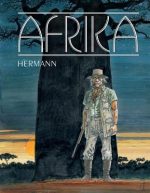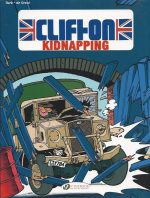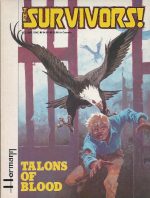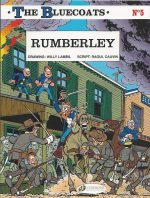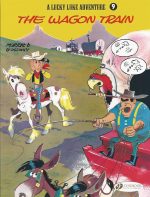
By André Franquin, translated by Jerome Saincantin (Cinebook)
ISBN: 978-1-84918-313-0
Win’s Christmas Gift Recommendation: Classic Madcap Mirth and Melodrama… 9/10
Spirou (which translates as both “squirrel†and “mischievous†in the Walloon language) was created by French cartoonist François Robert Velter using his pen-name Rob-Vel for Belgian publisher Éditions Dupuis in direct response to the phenomenal success of Hergé’s Tintin for rival outfit Casterman.
Thus, a soon-to-be legendary weekly comic entitled Spirou launched on April 21st 1938 with a rival red-headed lad as lead in an anthology which bears his name to this day.
The eponymous boy was originally a plucky bellboy/lift operator employed by the Moustique Hotel (a sly reference to the publisher’s premier periodical Le Moustique) whose improbable adventures with pet squirrel Spip gradually evolved into high-flying, far-reaching and surreal comedy dramas.
Spirou and his chums have spearheaded the magazine for most of its life, with a phalanx of truly impressive creators carrying on Velter’s work, beginning with his wife Blanche “Davine†Dumoulin who took over the strip when her husband enlisted in 1939. She was assisted by Belgian artist Luc Lafnet until 1943 when Dupuis purchased all rights to the property, after which comic-strip prodigy Joseph Gillain (“Jijéâ€) took the helm.
In 1946 Jijé’s assistant André Franquin assumed the creative reins, gradually sidelining the well-seasoned short gag vignettes in favour of epic adventure serials; introducing a broad, engaging cast of regulars and eventually creating phenomenally popular magic animal the Marsupilami to the mix.
First seen in Spirou et les héritiers in 1952, the elastic-tailed anthropoid eventually spun-off into his own strip series; becoming also a star of screen, plush toy store, console games and albums. Franquin continued concocting increasingly fantastic tales and spellbinding Spirou sagas until his resignation in 1969.
He was followed by Jean-Claude Fournier who updated the feature over the course of nine stirring adventures which tapped into the rebellious, relevant zeitgeist of the times: offering tales of environmental concern, nuclear energy, drug cartels and repressive regimes.
By the 1980s the series seemed outdated and without direction: three different creative teams alternated on the feature, until it was at last revitalised by Philippe Vandevelde – writing as Tome – and artist Jean-Richard Geurts AKA Janry, who adapted, referenced and in many ways returned to the beloved Franquin era.
Their sterling efforts revived the floundering feature’s fortunes and resulted in fourteen wonderful albums between 1984 and 1998. As the strip diversified into parallel strands (Spirou’s Childhood/Little Spirou and guest-creator specials A Spirou Story By…) the team on the core feature were succeeded by Jean-David Morvan & José-Luis Munuera, and in 2010 Yoann & Vehlmann took over the never-ending procession of amazing adventures…
Cinebook have been publishing Spirou & Fantasio’s exploits since 2009, alternating between Tome & Janry’s superb reinterpretations of Franquin and earlier efforts from the great man himself.
André Franquin was born in Etterbeek, Belgium on January 3rd 1924. Drawing from an early age, he only began formal art training at École Saint-Luc in 1943. When war forced the school’s closure a year later, he found work at Compagnie Belge d’Animation in Brussels. There he met Maurice de Bévère (AKA Lucky Luke creator “Morrisâ€), Pierre Culliford (Peyo, creator of The Smurfs) and Eddy Paape (Valhardi, Luc Orient). In 1945 all but Peyo signed on with Dupuis and Franquin began a career as a jobbing cartoonist and illustrator; producing covers for Le Moustique and Scouting magazine Plein Jeu.
In those early days Franquin and Morris were tutored by Jijé – the main illustrator at Spirou. He turned the youngsters and fellow neophyte Willy Maltaite AKA Will (Tif et Tondu, Isabelle, Le jardin des désirs) into a smooth creative bullpen known as the La bande des quatre or “Gang of Fourâ€.
They later reshaped and revolutionised Belgian comics with their prolific and engaging “Marcinelle school†style of graphic storytelling…
Jijé handed Franquin all responsibilities for the flagship strip part-way through Spirou et la maison préfabriquée, (Spirou #427, June 20th 1946) and the new guy ran with it for two decades; enlarging the scope and horizons until it became purely his own. Almost every week fans would meet startling new characters such as comrade/rival Fantasio or crackpot inventor and Merlin of mushroom mechanics the Count of Champignac.
Spirou and Fantasio became globe-trotting journalists, travelling to exotic places, uncovering crimes, exploring the fantastic and clashing with a coterie of exotic arch-enemies such as Zorglub and Fantasio’s rascally cousin Zantafio.
In a splendid example of good practise, Franquin mentored his own band of apprentice cartoonists during the 1950s. These included Jean Roba (La Ribambelle, Boule et Bill), Jidéhem (Sophie, Starter, Gaston Lagaffe) and Greg (Bruno Brazil, Bernard Prince, Achille Talon, Zig et Puce), who all worked with him on Spirou et Fantasio over the years.
In 1955 contractual conflicts with Dupuis droved Franquin to sign up with rival outfit Casterman on Tintin. Here he collaborated with René Goscinny and old pal Peyo whilst creating the raucous gag strip Modeste et Pompon. Although Franquin soon patched things up with Dupuis and returned to Spirou – subsequently co-creating Gaston Lagaffe in 1957 – Franquin was now contractually obliged to carry on his Tintin work too…
From 1959 on, co-writer Greg and background artist Jidéhem increasingly assisted Franquin but by 1969 the artist had reached his limit and resigned.
His later creations include fantasy series Isabelle, illustration sequence Monsters and bleak adult conceptual series Idées Noires, but his greatest creation – and one he retained all rights to upon his departure – is Marsupilami.
Plagued in later life by bouts of depression, Franquin passed away on January 5th 1997. His legacy remains; a vast body of work which reshaped the landscape of European comics.
Originally serialised in Spirou # 840-869 in 1954 and subsequently released on the continent in 1957 as hardcover album Spirou et Fantasio 8 РLa mauvaise t̻te, this sinister yarn begins as Spirou visits his short-tempered pal Fantasio and finds the house a shambles. The intrepid reporter has ransacked his home in search of missing passport photos but his insensate fury abates a bit after Spirou convinces him to come play paddleball.
However, whilst looking for a lost ball in the woods, Spirou finds one of the missing photos but thinks nothing of it…
That evening strange events begin: Spirou sees Fantasio acting oddly in town and when a jeweller is robbed, a brutalised merchant identifies Fantasio as the smash-and-grab thief…
Seeds of suspicion are sown and Spirou doesn’t know what to think when a solid gold Egyptian mask is stolen on live TV. The bandit is clearly seen to be his best pal…
Spirou is still trying to reason with Fantasio when the police arrive and, with nobody believing the reporter’s ridiculous story of being in Paris on a spurious tip, watches with helpless astonishment as the accused makes a bold escape bid…
Still astounded, Spirou wanders to the ramshackle house where he found the missing photo and finds a strange set-up: a plaster cast of Fantasio and weird plastic goo in a mixing bowl…
His snooping is suddenly disturbed by screams and sounds of a struggle. Following the cacophony he finds one man holding the stolen gold mask and another on the floor. The standing man is too quick to catch and drives away with a third stranger, but as Spirou questions the beaten victim he learns that the loser of the fight is a sculptor who was hired to make astounding life-like masks of a certain journalist…
Soon Spirou is hot on the trail of the criminal confederates and uncovers a diabolical scheme to destroy Fantasio by an old enemy they had both discounted and almost forgotten…
Fast-paced, compellingly convoluted and perfectly blending helter-skelter excitement with keen suspense and outrageous slapstick humour, the search for The Wrong Head is a terrific romp to delight devotees of easy-going adventure.
As if the criminal caper and its spectacular courtroom drama climax is not enough, this tome also includes a sweet early solo outing for the marvellous Marsupilami as ‘Paws off the Robins’ finds the plastic pro-simian electing himself guardian of a nestful of newborn hatchlings in Count Champignac’s copious gardens, resolved to defend the chicks from a marauding cat at all costs…
Stuffed with fabulously fun, riotous chases and gallons of gags, this exuberant tome is a joyous example of angst-free action, thrills and spills. Easily accessible to readers of all ages and drawn with beguiling style and seductively wholesome élan, this is pure cartoon gold: an enduring comics treat, certain to be as much a household name as that other kid reporter and his dog…
Original edition © Dupuis, 1957 by Franquin. All rights reserved. English translation 2016 © Cinebook Ltd.
